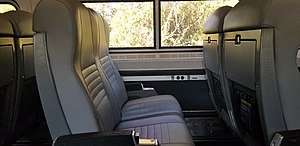| Amfleet | |
|---|---|
 Amfleet I coaches at Kingston station, Rhode Island | |
 Amfleet I coach seats | |
| In service | 1975–present (Amfleet I) 1981–present (Amfleet II) |
| Manufacturer | Budd Company |
| Built at | Philadelphia, PA |
| Family name | Budd Metroliner |
| Number built |
|
| Number in service |
|
| Formation | Single car |
| Fleet numbers |
|
| Capacity | Up to 84 seats |
| Operators | Amtrak |
| Specifications | |
| Car body construction | Stainless steel |
| Car length | 85 ft 4 in (26.01 m) |
| Width | 10 ft 6 in (3.20 m) |
| Height | 12 ft 8 in (3.86 m) |
| Floor height | 51+1⁄2 inches (1.31 m) |
| Platform height |
|
| Doors |
|
| Maximum speed | 125 miles per hour (201 km/h) |
| Weight | 106,000–113,000 pounds (48,000–51,000 kg) |
| Power supply | 480 V AC |
| HVAC | Electric heat and air conditioning |
| Bogies | Budd Pioneer |
| Braking system(s) | Pneumatic, 2 tread and 2 disc per axle. |
| Coupling system | AAR type H |
| Track gauge | 4 ft 8+1⁄2 in (1,435 mm) standard gauge |
Amfleet is a fleet of single-level intercity railroad passenger cars built by the Budd Company for American company Amtrak in the late 1970s and early 1980s. Budd based the Amfleet design on its earlier Metroliner electric multiple unit. An initial order for 57 cars in 1973 to supplement the Metroliners on the Northeast Corridor grew to two orders totaling 642 cars, sufficient to reequip all the services on the Northeast Corridor and many other routes around the United States. The first 492 cars, known as Amfleet I and completed between 1975 and 1977, were designed for short-distance service. A second order of 150 cars, known as Amfleet II and completed between 1980 and 1983, were designed for long-distance service. They were the last intercity passenger cars built by Budd.
Car types include both long- and short-distance coaches, cafes, club cars, and lounges. Since the construction of the cars, multiple rebuildings have eliminated the club cars and lounges in favor of business class cars, club-dinettes, and "diner-lite" dining cars. Amtrak experimented with sleeping car conversions in the 1970s, but did not pursue the idea. The Amfleet I has vestibules on both ends of the car for faster unloading, while the Amfleet II has a single vestibule. The Amfleet II also has slightly larger windows.
The Amfleets were the first new locomotive-hauled intercity cars ordered by Amtrak and the first such cars built in the United States since 1965. Their introduction in the mid-1970s led to improved reliability for Amtrak's trains and ridership gains. As of 2023[update], Amfleet cars are used extensively in the eastern and midwestern United States, forming the backbone of Amtrak's single-level fleet, with 580 out of the original 642 in service as of October 1, 2023.[2]